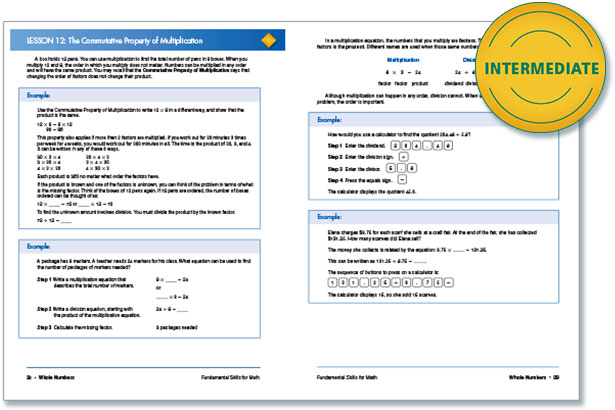Math consists of eleven modules, representing three levels (Literacy, Grades 0–1.9; Beginning, Grades 2–3.9; and Intermediate, Grades 4–5.0) of Student Materials plus an Instructor Edition. The modules consist of:

Number Sense Literacy
Unit focuses on building knowledge of fractions, whole numbers, multiplication, division, and problem solving.
Algebra, Measurement, and Data Analysis Literacy
Units strengthen foundational skills in equations, measurements, and understanding data.

Number Sense Beginning
Unit covers concepts learned in Number Sense Literacy and extends knowledge to multi-digits and fractions, multiplication, division, and problem solving.
Geometry and Measurement Beginning
Unit focuses on units of measurement, shapes, scales, and temperature.
Algebra, Statistics, Data Analysis, Probability
Unit covers properties, equations, and how to interpret data.

Whole Numbers Intermediate
Unit covers the Commutative, Associative, and Distributive Properties; Multiplication; Division; and Estimation concepts.
Fractions, Decimals, Percent & Ratios Intermediate
Unit expands on foundational skills in these areas by introducing problems of greater difficulty as well as percent.
Algebra Intermediate
Unit focus is on the use of numeric patterns and relationships, equations, and sequences.
Geometry Intermediate
Unit introduces symmetry, shapes, angles, and two-dimensional and three-dimensional figures.
Measurement Intermediate
Unit focuses on measurements, time, temperature, shapes, length, and weight.
Statistics, Data Analysis & Probability Intermediate
Unit focus is on analyzing various types of tables and using previously taught skills to read the graphs.
The Math Instructor Edition provides resources and lesson plans which support the Literacy, Beginning Basic, and Intermediate Basic levels of the Student Editions. The guide offers suggestions and materials for a logical progression of instruction for the educator and learner alike.